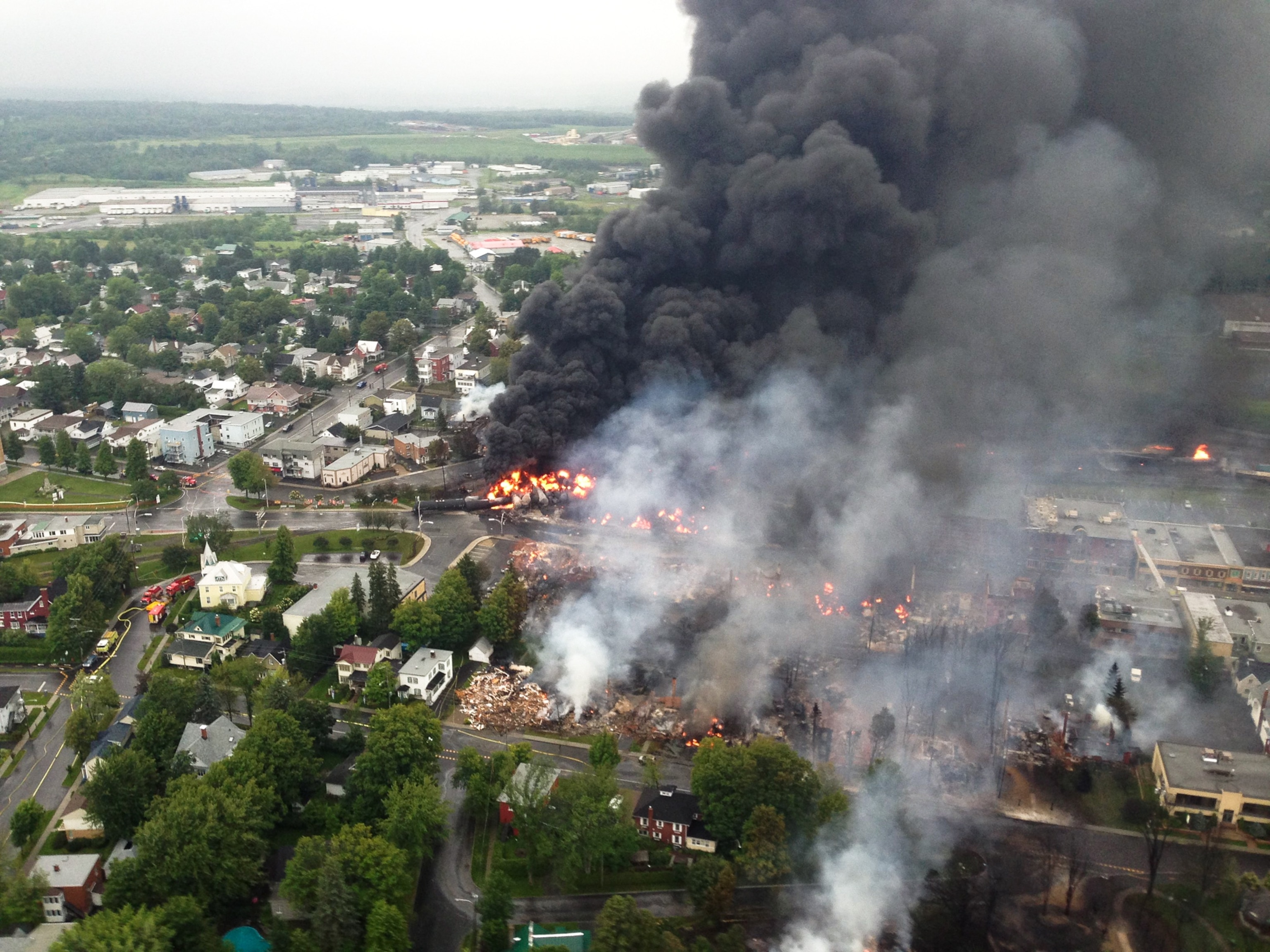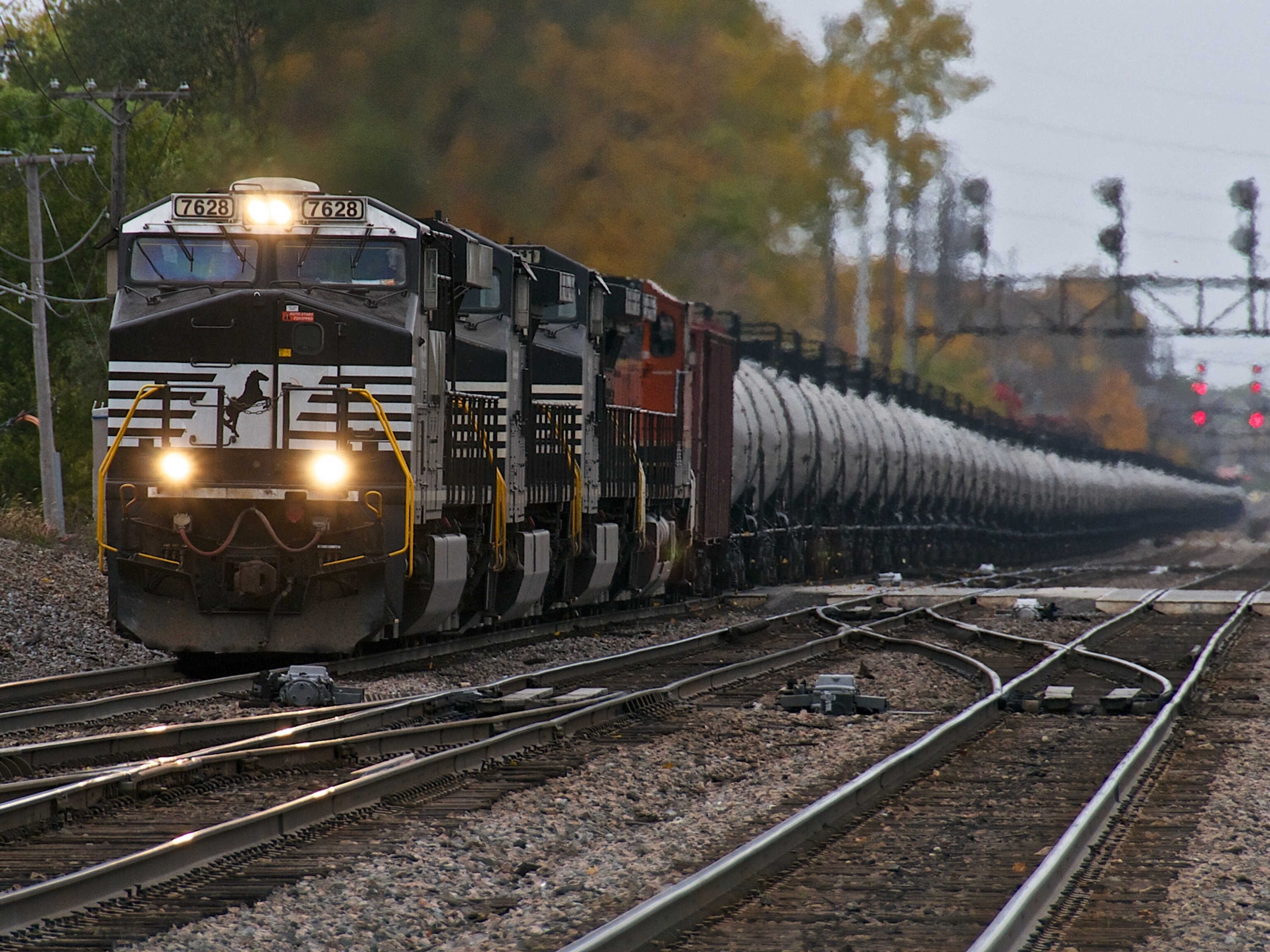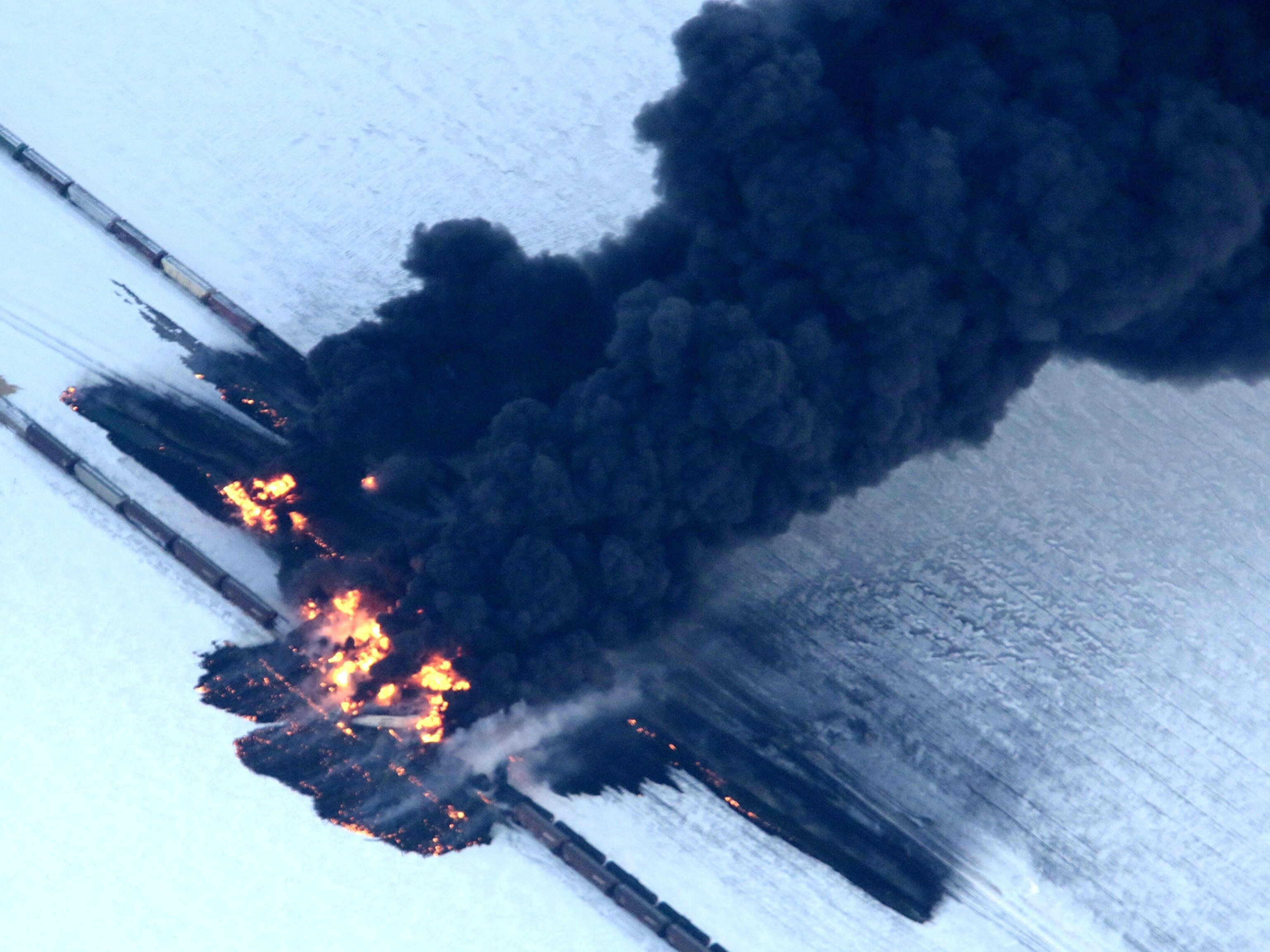
Eight Steps for Safer Oil Trains Eyed by U.S. Officials
U.S. officials are weighing a wide range of actions to address what they view as the increasing public risk due to oil trains. Thanks to the booming oil production in North Dakota’s Bakken shale, and the ramp-up of ethanol production throughout the Midwest, U.S. railways now are carrying an unprecedented volume of flammable liquid—and the majority of tank cars used for those liquids are prone to be punctured in an accident, safety investigators have been warning for 20 years. (See related story: “Illinois Village Leads Charge for Tougher Oil Train Rules.”)
An unusual meeting between U.S. Transportation Secretary Anthony Foxx and oil and rail industry officials on Thursday indicated that authorities are looking at steps beyond just bolstering the notorious DOT-111 tank car, a measure that is itself controversial and potentially costly. Here are some of the measures under consideration:
Tank Car Overhaul. The DOT-111 tank cars have top fittings which project from the tank and are vulnerable to damage in derailments. Roll bars, a deflective skid, or recessed fittings are possible solutions. Head shields, or extra protection at the ends of the tanks, also would add to puncture resistance. The rail industry is recommending that an outer steel jacket be added to tank cars, to provide greater puncture resistance and thermal protection. And bottom outlet valves must be built to remain closed in an accident, even when the operating handle is subject to impact. The cost of retrofittting the U.S. tank car fleet with these improvements is believed to be more than $1 billion. (See related story: “Oil Train Revival: North Dakota Relies on Rail to Deliver Its Crude.”)
New Routes. Transportation officials reportedly are studying whether trains carrying flammable liquids should be re-routed to avoid cities. Currently, they are traveling through dozens of U.S. cities, from Seattle to Philadelphia. Perhaps the largest concentration is in the Midwest, where so many of the large freight lines converge, including Chicago, the largest rail hub in the United States. The problem is that many of the cities are not just pass-through points but have refineries that are ultimate destinations for the oil.
Slow-Down. Since last August, the U.S. rail industry has had a standard in place that limits “key trains,” those with 20 car loads or more of hazardous material, to 50 miles per hour. U.S. officials are considering whether oil trains should be slowed down further in certain locations to lessen public risk.
Real-Time Data. The National Transportation Safety Board (NTSB) for years has been urging that a real-time electronic data system be established for conveying car-by-car information to emergency responders on what cargo is contained in each tank car. Under current practice, the train “consist,” or list, is kept in paper form on the train in the locomotive. The NTSB has cited numerous instances where emergency responders were stymied by missing or incorrect train consist information.
Better Railroads. Federal officials have indicated they will weigh whether action is needed to improve rail integrity, addressing broken rails and welds, misaligned track, obstructions, and faults in track geometry—all of which have been linked to derailments of recent years.
Positive Train Control. An item on the NTSB’s “most wanted” list of transportation safety improvement, Positive Train Control would be a next-generation technology that could automatically slow down trains if hazards are identified on tracks. Regulators, however, are not sure if the technology is ready or if they have the resources to oversee such systems.
Addressing “More Volatile” Oil. U.S. authorities are dealing with emerging concerns that the particular make-up of Bakken oil may make it more dangerous. The Pipeline and Hazardous Materials Safety Administration issued a safety alert on January 2 that “the type of crude oil being transported from the Bakken region may be more flammable than traditional heavy crude oil.” Crude oil, they say, is hard to ignite before refining, and typically does not explode, but has done so in several recent accidents, most notably, at Lac-Megantic, in Canada last summer. They believe that Bakken crude may contain large amounts of natural gas by-products and liquids like butane, propane, and ethane. (See related photos: “Bakken Shale Oil Boom Transforms North Dakota.”)
Steps on Increasing Corrosion Incidents. A separate, but related issue, is whether crude from the Bakken—produced through hydraulic fracturing, or fracking—and possibly from the Canadian oil sands is more corrosive than conventional oil, either because of its natural content or the chemicals or contaminants used in production. The Natural Resources Defense Council and a coalition of environmental groups raised the issue in comments to federal regulators this fall. They attached a July 2013 letter from the Federal Railway Administration to the oil industry’s American Petroleum Institute, noting that the agency was seeing an increasing number of incidents involving damage to tank cars in crude oil service in the form of severe corrosion of the internal surface of the tank car, covers, and valves and fittings. “A possible cause is contamination of the crude oil by materials used in the fracturing process that are corrosive to the tank car tank and service equipment,” the FRA said. More robust lining of tank cars could be needed. On Thursday, Foxx asked the petroleum industry to share information on the content of Bakken oil with PHMSA, which is conducting its own studies. (See related story: “Oil Spill Spotlights Keystone XL Issue: Is Canadian Crude Worse?“)
Related Topics
You May Also Like
Go Further
Animals
- How can we protect grizzlies from their biggest threat—trains?How can we protect grizzlies from their biggest threat—trains?
- This ‘saber-toothed’ salmon wasn’t quite what we thoughtThis ‘saber-toothed’ salmon wasn’t quite what we thought
- Why this rhino-zebra friendship makes perfect senseWhy this rhino-zebra friendship makes perfect sense
- When did bioluminescence evolve? It’s older than we thought.When did bioluminescence evolve? It’s older than we thought.
- Soy, skim … spider. Are any of these technically milk?Soy, skim … spider. Are any of these technically milk?
Environment
- Are the Great Lakes the key to solving America’s emissions conundrum?Are the Great Lakes the key to solving America’s emissions conundrum?
- The world’s historic sites face climate change. Can Petra lead the way?The world’s historic sites face climate change. Can Petra lead the way?
- This pristine piece of the Amazon shows nature’s resilienceThis pristine piece of the Amazon shows nature’s resilience
- Listen to 30 years of climate change transformed into haunting musicListen to 30 years of climate change transformed into haunting music
History & Culture
- Meet the original members of the tortured poets departmentMeet the original members of the tortured poets department
- Séances at the White House? Why these first ladies turned to the occultSéances at the White House? Why these first ladies turned to the occult
- Gambling is everywhere now. When is that a problem?Gambling is everywhere now. When is that a problem?
- Beauty is pain—at least it was in 17th-century SpainBeauty is pain—at least it was in 17th-century Spain
Science
- Here's how astronomers found one of the rarest phenomenons in spaceHere's how astronomers found one of the rarest phenomenons in space
- Not an extrovert or introvert? There’s a word for that.Not an extrovert or introvert? There’s a word for that.
- NASA has a plan to clean up space junk—but is going green enough?NASA has a plan to clean up space junk—but is going green enough?
- Soy, skim … spider. Are any of these technically milk?Soy, skim … spider. Are any of these technically milk?
Travel
- Dina Macki on Omani cuisine and Zanzibari flavoursDina Macki on Omani cuisine and Zanzibari flavours
- How to see Mexico's Baja California beyond the beachesHow to see Mexico's Baja California beyond the beaches
- Could Mexico's Chepe Express be the ultimate slow rail adventure?Could Mexico's Chepe Express be the ultimate slow rail adventure?







